(This is an element of ‘Cooking‘)
I have no way of knowing if William Sugg coined the name ‘Gas Kitchener’ but it is clear what was being aimed at with this name. Prior to the development of the gas cooking appliance, many kitchens would have been equipped with a wood or coal fired ‘range’ which would provide an oven and a hotplate for cooking and heating water. The introduction of an appliance that ‘Roasts, Boils, Fries, Grills and Bakes Pastry or Bread by Means of Luminous Flames’ is clearly revolutionary and the name ‘Kitchener’ provides a neat overall description.
It is interesting to note a number of features in the illustration above in particular the method of hanging the joint within the oven. This method would have been used predominantly in the past because the source of heat being a fire was directly below the joint and the use of a roasting tin would have interrupted the whole process. The dripping fat would have added to the process on the open fire whereas the gas Kitchener has been provided with an ‘enamelled iron dripping pan’. It may well be that the hanging arrangement is offered as something ‘familiar’ to the new customer. It is not long before this arrangement is no longer offered. Of course, the size of the joint is also a factor and William Sugg in one of his lectures claims a great saving in the ‘shrinkage’ which occurred with previous methods. This may have meant that the customer could actually buy a smaller joint when equipped with a gas Kitchener!
The essential arrangement used on gas (and electric) cookers for at least a century remains almost unchanged. The ‘grilling’ area below the top plate, the control for the temperature of the oven, the enamelled inside to the oven, even the ‘flashlight’ or ‘pilot’ of more recent times for gas are part of this design which is dated around 1880 – and all for £20 excluding the ‘Utensils’!
Here is the ultimate domestic Gas Kitchener illustration from William Sugg’s book, “The Domestic Uses of Coal Gas”. As you can see the Kitchener itself includes a built-in gas fire and a water supply and is paired up with both a Plate Warmer and a Therma ‘instantaneous’ water heater. I cannot imagine the gas fire being used whilst cooking without burning the cook or setting fire to his/her clothes. Probably the fire was used to heat the room prior to cooking – or to sit round after work was completed!
Despite this last comment I have now (2014) discovered that the NOTE on the illustration that says ‘The Roasting Screen is omitted so that the construction of the fire can be seen’ indicates that this feature was included in order to allow the cook to roast a joint in front of the fire in exactly the same way that this would have been done in a coal fired range so ensuring there was no excuse not to buy!
This is a page from Jenny Sugg’s ‘The Art of Cooking by Gas’ of 1890. Note the water heating arrangement on the left with a tap for drawing off.
UNDER CONTINUOUS DEVELOPMENT – PLEASE TRY AGAIN LATER
Copyright © Chris Sugg 2006-13
Top of page
or
Back to Cooking

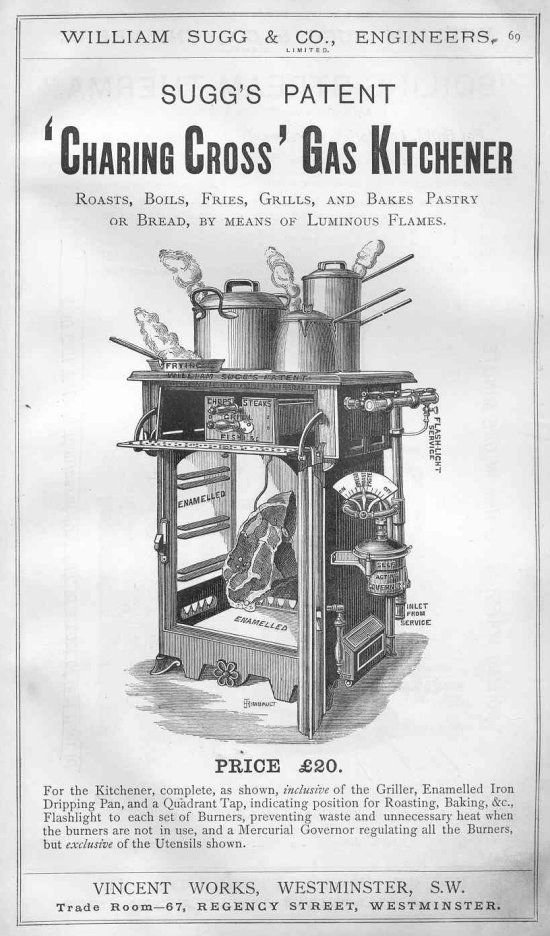
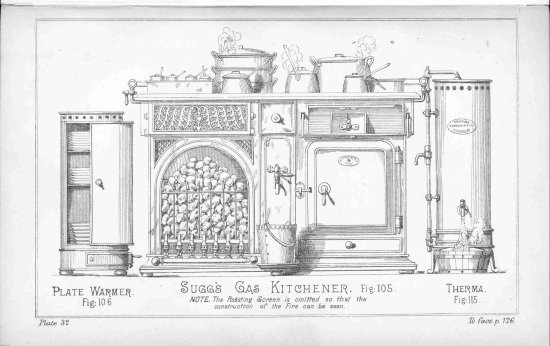
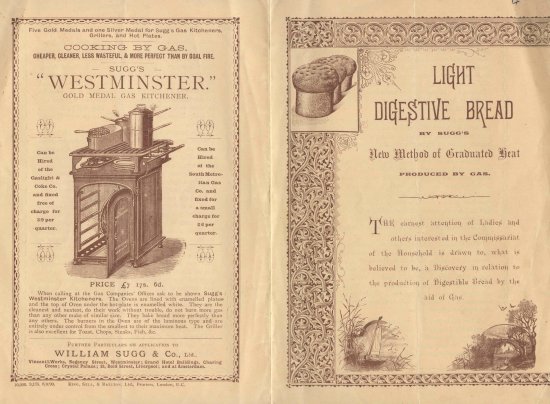
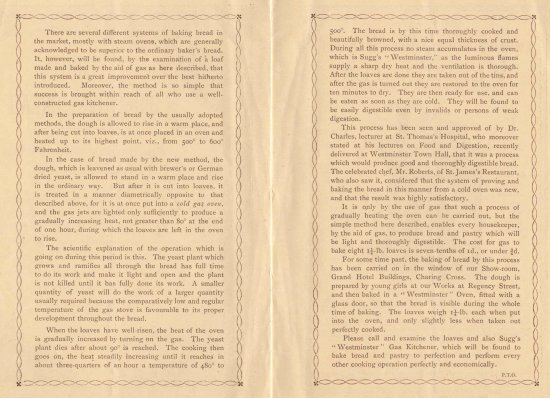
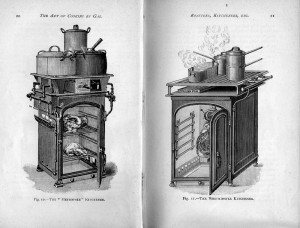
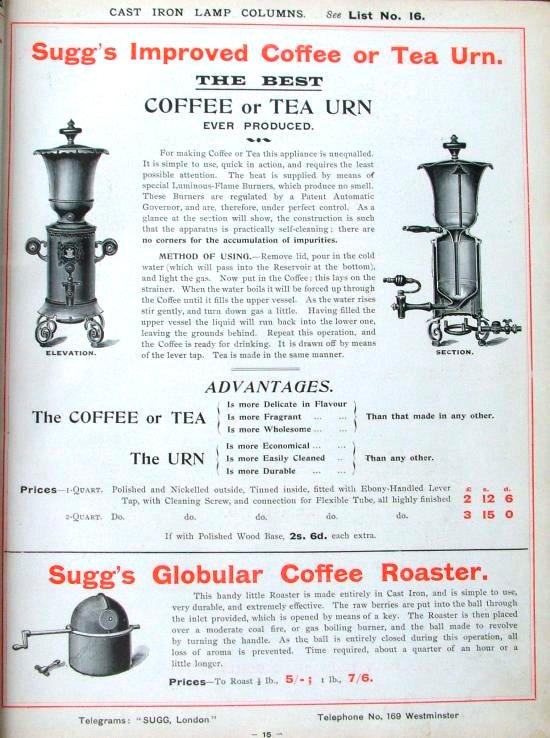
4 responses
Hi, I’ve been collecting these old GLC domestic gas cookers about 1935 plus, and I have a small ‘fleet’ of them with friends and neighbours around my street in London Fields, London, plus my own which I keep in near perfect condition. They still look and work great and these are likely the only ones left in use. I’ve taken it upon myself to try and keep a living memory going. Can mail a grew pics if you interested. Basically I’m keeping them out of skips.
One of them recently got condemned by the plumber due to a small leak on the ball valve taps. The girl who runs it needed help but I can’t find anybody at all to help, not having any contacts with any idea. ‘Just get a new cooker’. I can’t find any graphite paste to do it. I’m not a plumber, just a busy, family guy in his 40s.
In the appliances history on your site this type of cooker is shown, a GLC 0 I think. But the one above is a North London gas Company variety, unique and it came from a school attic where it sat unused for 80 years or so, until I was tasked with remodelling area. Shame to see it go out of use for a trivial leak. Can you help?
Thanks Stewart
Hello Stewart, sorry for delay in replying – it’s that time of year! I am a bit surprised that you mention ball valves as these are a modern type of tap and they really can’t be reground. A traditional tapered cone type tap can be reground – carefully – so long as you can take up the ‘slack’ when the plug inevitably moves a tiny amount into the cone once reground.They often have a screw and washer which can be used to tighten it up although it may be necessary to take a fraction off the mating surfaces to allow the necessary movement. I would love to have some photos of your collection and would be happy to show them on my site. You will see many manufacturers shown in the paper my father wrote in the section Gas Utilisation. The cooker section is at https://williamsugghistory.co.uk/?page_id=30#cooker I could perhaps add them close to relevant equivalents in this section.
Incidentally, I use fine valve grinding paste to grind in gas taps. Just make sure you remove all traces otherwise you will eventually get scoring. If you also send me a close-up of the problem tap I may be able to make further suggestions. Chris
I have an 1891 cookery book by Mrs. Wilkinson with an illustration of the ‘Westminster’ Gas Kitchener, with directions upon the management of cooking by gas.
Thank you Ann, the use of the name ‘kitchener’ seems to have been used to describe cookers that were capable of doing multiple things such as heating water. I would love to see a copy of the page with the illustration and perhaps relevant comments by Mrs Wilkinson. The editor of Historic Gas Times or HGT which is produced 3 or 4 times a year is also called Wilkinson so I am sure he would love to quote his namesake with a picture of the book and the appliance and text. A photo of the pages is the easiest way to copy these days!